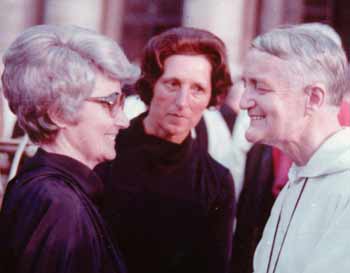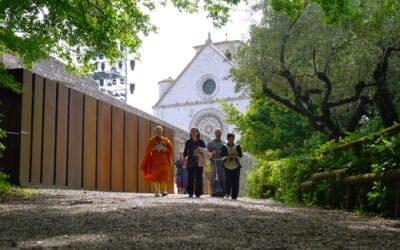 There is one event in the life of Igino Giordani that urges us to pause and reflect: the first biography written about him in 1985 was not written by a Catholic, but by a Scottish Baptist pastor, Edwin Robertson[1]. We should not see this as an irony of history [. . .] if such a friendly gesture towards Giordani had merit in the eyes of Heaven and in front of human history. Giordani had already presided at a conference of ecumenists back in the fall of 1967, at the headquarters of the Movement in Rocca di Papa, Italy. The Very Reverend Archimendrite, Eleuterio Fortino was also present. Years later in 2004, he gave the following testimony: “Because of his own interior serenity, Giordani was able to calm the heated tones of the debates at that conference; and he clarified the theological and pastoral aspects of the Second Vatican Council’s Unitatis redintegratio (1965), bringing down the last resistance of the Italian opposition to common prayer among all Christians during the Week of Prayer for the Unity of Churches[2]. Giordani had already been following the Week of Prayer, which was actually an Octave, beginning on January 18 (feast of the Chair of St. Peter in Rome) to January 25 (feast of the Conversion of St. Paul). In 1940 Giordani writes: “During the preparations of the Octave, news spread that was at first uncertain, that at a certain monastery of Trappist nuns in Rome, they were praying intensely for an end to the divisions among Christians. I came to learn that a young nun of that monastery had offered her life for the unity of the Church and that her sacrificial death had deeply touched a community of separated brothers in England. The news, even though it was so vague, greatly expanded – at least in my eyes – the horizon of the unitary movement and opened new prospects that appeared as patches of blue breaking through the gray and stormy heavens over a brawling humanity. It placed the Octave and its goals in their true light. Those nuns probably didn’t know anything about all the debates and commissions and committees that were held on the topic. Placed in front of the problem of the secession, they had contemplated it in simplicity, in the light of the Rule that never changes: they saw that unity is to be sought where it is found, that is, at its source, at the matrix. In other words it has to be asked of the Father in whom – and only in whom – brothers unite. This means that those humble women whom you’ll never meet at any conference, knew immediately what had to be done, and they placed the unity movement on the most direct path. Some might be tempted to ask it from Hegel, Loisy or even Marx; and in the news and in the conferences the names of such people came up, who had not and can not provide anything but partial solutions. Unity is not the work of men, but of God: not of study, but of grace. Even so, Father, accept this too, above all for your Church, that you might deign to purify her, preserve her, and unify her …”[3].
There is one event in the life of Igino Giordani that urges us to pause and reflect: the first biography written about him in 1985 was not written by a Catholic, but by a Scottish Baptist pastor, Edwin Robertson[1]. We should not see this as an irony of history [. . .] if such a friendly gesture towards Giordani had merit in the eyes of Heaven and in front of human history. Giordani had already presided at a conference of ecumenists back in the fall of 1967, at the headquarters of the Movement in Rocca di Papa, Italy. The Very Reverend Archimendrite, Eleuterio Fortino was also present. Years later in 2004, he gave the following testimony: “Because of his own interior serenity, Giordani was able to calm the heated tones of the debates at that conference; and he clarified the theological and pastoral aspects of the Second Vatican Council’s Unitatis redintegratio (1965), bringing down the last resistance of the Italian opposition to common prayer among all Christians during the Week of Prayer for the Unity of Churches[2]. Giordani had already been following the Week of Prayer, which was actually an Octave, beginning on January 18 (feast of the Chair of St. Peter in Rome) to January 25 (feast of the Conversion of St. Paul). In 1940 Giordani writes: “During the preparations of the Octave, news spread that was at first uncertain, that at a certain monastery of Trappist nuns in Rome, they were praying intensely for an end to the divisions among Christians. I came to learn that a young nun of that monastery had offered her life for the unity of the Church and that her sacrificial death had deeply touched a community of separated brothers in England. The news, even though it was so vague, greatly expanded – at least in my eyes – the horizon of the unitary movement and opened new prospects that appeared as patches of blue breaking through the gray and stormy heavens over a brawling humanity. It placed the Octave and its goals in their true light. Those nuns probably didn’t know anything about all the debates and commissions and committees that were held on the topic. Placed in front of the problem of the secession, they had contemplated it in simplicity, in the light of the Rule that never changes: they saw that unity is to be sought where it is found, that is, at its source, at the matrix. In other words it has to be asked of the Father in whom – and only in whom – brothers unite. This means that those humble women whom you’ll never meet at any conference, knew immediately what had to be done, and they placed the unity movement on the most direct path. Some might be tempted to ask it from Hegel, Loisy or even Marx; and in the news and in the conferences the names of such people came up, who had not and can not provide anything but partial solutions. Unity is not the work of men, but of God: not of study, but of grace. Even so, Father, accept this too, above all for your Church, that you might deign to purify her, preserve her, and unify her …”[3].  Chiara Lubich called the ecumenism that has come from her, an “ecumenism of life”. It is still practiced by the Focolare and has well developed experiences of its own experiences, developing in the light of great men like John XXIII, Paul VI, and in the light of the Second Vatican Council. It became one of the main priorities of Igino Giordani during the final years of his life. For Giordani, all Christians were already long-lost brothers and sisters. He lived and spread an ecumenical spirit that was composed of love and aimed at communion, in the certainty that “from the unity of hearts comes unity of minds”.[4]. It is rather touching to see how his article on ecumenism, The Journey Towards Unity, was written by in December 1979, four months before his departure for Heaven. In that gesture he continued to tenaciously cultivate a prophetic vision, in which he set the unity of Christians as the basis and the leaven that would “give an impetus to the ideal of universal unity among all peoples [5]. (Compiled by: Tommaso Sorgi, Il percorso ecumenico di Igino Giordani, “Nuova Umanità” No.199). ________________________________________ [1] E. Robertson, Igino Giordani, Città Nuova, Rome 1985. Ed. English edition entitled: The Fire of love. A life of Igino Giordani ‘Foco’, New City, London 1989. [2] E. Fortino, Igino Giordani e la preghiera per l’unità dei cristiani, in “Besa-Fede”, Greek-Albanese Journal, Rome, February 2004, pp. 7-9. [3] I. Giordani, Questa ottava, in: M. G. Dore, Suor Maria Gabriella (1914-1939), Morcelliana, Brescia 1940, pp. 9-25. [4] I. Giordani, Sette giorni per l’unità, “Città Nuova”, 1978, n. 23, p.30. [5] I. Giordani, Il viaggio verso l’unità, “Città Nuova”», 1979, n. 23, p.27.
Chiara Lubich called the ecumenism that has come from her, an “ecumenism of life”. It is still practiced by the Focolare and has well developed experiences of its own experiences, developing in the light of great men like John XXIII, Paul VI, and in the light of the Second Vatican Council. It became one of the main priorities of Igino Giordani during the final years of his life. For Giordani, all Christians were already long-lost brothers and sisters. He lived and spread an ecumenical spirit that was composed of love and aimed at communion, in the certainty that “from the unity of hearts comes unity of minds”.[4]. It is rather touching to see how his article on ecumenism, The Journey Towards Unity, was written by in December 1979, four months before his departure for Heaven. In that gesture he continued to tenaciously cultivate a prophetic vision, in which he set the unity of Christians as the basis and the leaven that would “give an impetus to the ideal of universal unity among all peoples [5]. (Compiled by: Tommaso Sorgi, Il percorso ecumenico di Igino Giordani, “Nuova Umanità” No.199). ________________________________________ [1] E. Robertson, Igino Giordani, Città Nuova, Rome 1985. Ed. English edition entitled: The Fire of love. A life of Igino Giordani ‘Foco’, New City, London 1989. [2] E. Fortino, Igino Giordani e la preghiera per l’unità dei cristiani, in “Besa-Fede”, Greek-Albanese Journal, Rome, February 2004, pp. 7-9. [3] I. Giordani, Questa ottava, in: M. G. Dore, Suor Maria Gabriella (1914-1939), Morcelliana, Brescia 1940, pp. 9-25. [4] I. Giordani, Sette giorni per l’unità, “Città Nuova”, 1978, n. 23, p.30. [5] I. Giordani, Il viaggio verso l’unità, “Città Nuova”», 1979, n. 23, p.27.
Put love into practice
Put love into practice




0 Comments